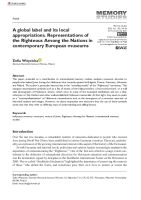A global label and its local appropriations: Representations of the Righteous Among the Nations in contemporary European museums
Author(s)
Publication Name
Publication Date
Abstract
This paper, intended as a contribution to transnational memory studies, analyzes museums devoted to people who helped Jews during the Holocaust that recently opened in Bulgaria, France, Germany, Lithuania, and Poland. The author’s particular interest lies in the “traveling motifs” of the “Righteous” narratives. This category encompasses symbols such as a list of names of the help-providers, a fruit tree/orchard, or a wall with photographs of Holocaust victims, which recur in many of the examined exhibitions and are a clear reference to Yad Vashem and other well-established Holocaust memorials. At first sight, they seem to point to a “cosmopolitanization” of Holocaust remembrance and to the emergence of a common reservoir of historical notions and images. However, on closer inspection one discovers that the use of these symbols varies and that they refer to differing ways of understanding and telling history.
Topics
Genre
Geographic Coverage
Copyright Info
This article is distributed under the terms of the Creative Commons Attribution-NonCommercial 4.0 License (https://creativecommons.org/licenses/by-nc/4.0/) which permits non-commercial use, reproduction and distribution of the work without further permission provided the original work is attributed as specified on the SAGE and Open Access pages (https://us.sagepub.com/en-us/nam/open-access-at-sage).
Original Language
Volume/Issue
15(1)
Page Number / Article Number
20-36
DOI
Bibliographic Information
A global label and its local appropriations: Representations of the Righteous Among the Nations in contemporary European museums. 2021: 20-36. https://archive.jpr.org.uk/10.1177/17506980211017928




